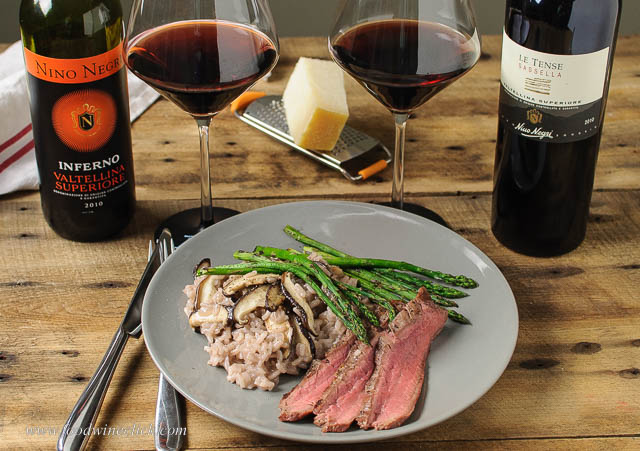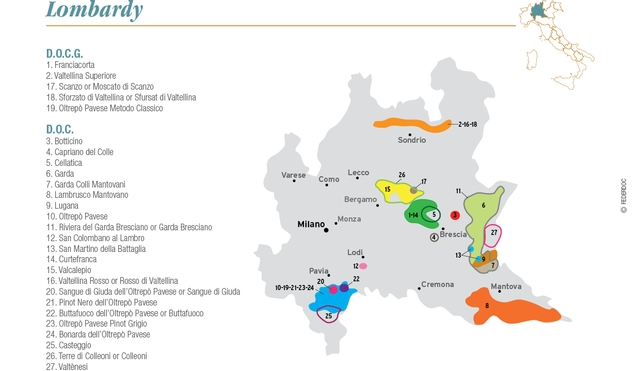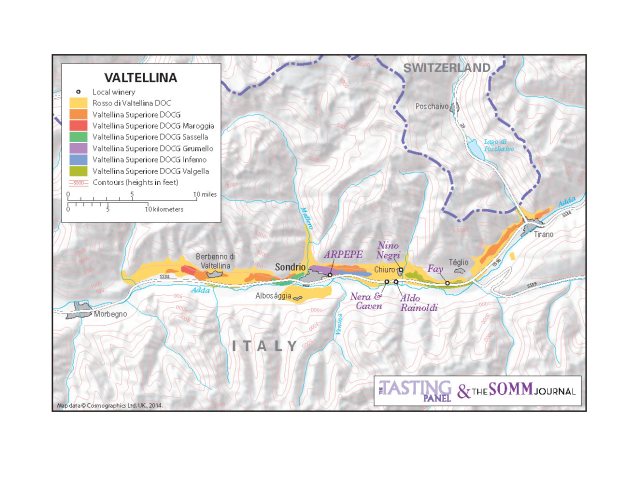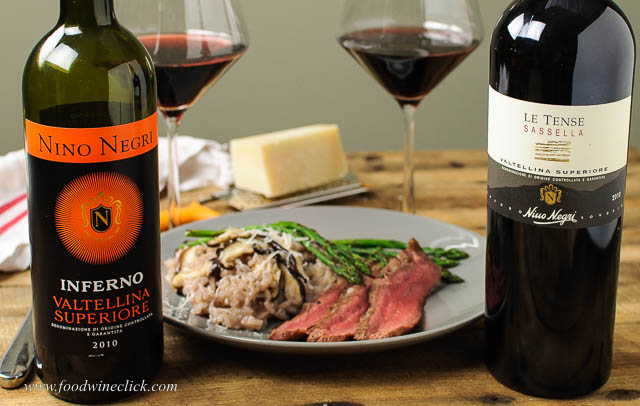Valtellina: Another Expression of Nebbiolo #ItalianFWT
Posted by foodwineclick on May 6, 2016 · 17 Comments

Valtellina wines, arborio rice, Taleggio and Grana Padano all hail from Lombardia
#ItalianFWT Visits Lombardia, FoodWineClick Digs into Valtellina
The month of May brings our Italian Food, Wine & Travel (#ItalianFWT on twitter) group to Lombardy (Lombardia). Located in north central Italy, Lombardy is the home of much of Italian industry (Beretta), fashion (Milan!), and also for its beautiful lakes region including the well known Lakes Maggiore, Como, and Garda. Franciacorta sparkling wines hail from this region. Valtellina? Most have never heard of Valtellina, a winegrowing region up to the north, in the foothills of the alps. Valtellina will be my focus for the month!

Lombardy map courtesty of http://www.wineandtravelitaly.com
Valtellina – Almost in the Alps
Valtellina Superiore and Sforzato di Valtellina are two DOCG wines which are made only in this small, northern region. I was excited to try these red wines, as they are based on the Nebbiolo grape, a favorite of mine. In normal European fashion, the wines are labeled for the town or region, so they are called Valtellina. In addition, they have another name for the Nebbiolo grape here: Chiavennasca. Just to keep us all guessing. The Valtellina valley runs east-west, carved by the Adda river. Like many winegrowing regions in cooler climates, the vineyards are all situated on the steep, terraced north side of the river so they can maximize heat and light from the sun.

Valtellina map courtesy of Tasting Panel and Somm Journal.
Does Place Really Matter? Can You Taste It?
Within the Valtellina Superiore DOCG, there are 5 sub-regions: Maroggia, Sassella, Grumello, Inferno, and Valgella. Each sub region has its own character, with Inferno being well established as the warmest of the five. This post is all about comparing two almost identical wines from the same winery and same vintage, with nearly identical vineyard practices and treatment in the cellar. Inferno vs. Sassella, can you tell the difference?

Valtellina Superiore from two neighboring hillsides
Side by side Comparison of Stats
| Variable | La Tense Sassella | Inferno |
| Grape | 100% Chiavennasca | 95% Chiavennasca, 5% Pignola & Merlot |
| Vineyard altitude | 1200 feet | 1200-1600 feet |
| Vine training | Arched variant of Guyot | Arched variant of Guyot |
| Vine density | 3500 vines/acre | 3500 vines/acre |
| Harvest date | Early October | Mid-late October |
| Vinification | 5 days maceration, temp. control 25-28° C | 10 days maceration, temp. control 25-28° C |
| Post-fermentation | Stainless steel tank 2-3 months | Stainless steel tank 2-3 months |
| Aging | 18-20 months in used small French oak barrels and large 30HL casks | 18 months in large French & Slavonian oak casks |
The % alcohol, acidity and residual sugar numbers were also very similar. Judging by the numbers alone, you would guess you’d have trouble telling these two wines apart. Wrong!

That beautiful pale ruby color catches the light
Nino Negri Sassella “La Tense” Valtellina Superiore DOCG 2010 ($30)
Eye: Clear, pale ruby with an orange edge
Nose: Medium + intensity, the aroma comes out of the glass to greet you. Cinnamon with evergreen needles, followed by red fruit.
Mouth: A boldly textured wine with lively acidity and strong tannins. Flavors include red cherries & evergreen.
Somehow different from Piemonte, this is clearly recognizable as Nebbiolo. All that power and structure from such a pale red liquid in the glass, how do they do it!

Inferno comes from the hottest of the 5 sub-region hillsides
Nino Negri “Inferno” Valtellina Superiore DOCG 2010 ($25)
Eye: Clear, pale ruby color with an orange edge. Side by side in equal light, these two wines look virtually identical.
Nose: Initially shy, I needed to get my nose deep into the glass to really smell what was going on. Dark red fruit, ripe black cherries, a bit of evergreen but in the background.
Mouth: Full bodied, it’s very tannic but the acidity seems to be either low or very well masked. Blind, I would have a hard time pegging this as Nebbiolo, except for that pale color!
I was shocked how two wines from neighboring hillsides on the same side of the river, grown, vinified and matured almost identically, could be so different. Whether or not you believe in terroir, place matters.
Italian Food Wine & Travel Lombardia Reports
Join our Twitter chat Saturday May 7th at 10am CDT @ #ItalianFWT to chat about Lombardia. Plus, don’t miss next month as we feature our last region of Italy, Liguria. This will complete our first full tour of Italy. See you June 4th!
Vino Travels – Chiavennasca of Lombardia vs. Nebbiolo of Piedmont
The Wining Hour – Vines and Views of Valtellina Valley
Culinary Adventures of Camilla – Sbrisolana and Cantina Casteggio Barbera
Girls Gotta Drink – Visit Franciacorta Wine Region: Italian Sparkling Wine For the Win!
Enofylz Wine Blog– Franciacorta: The World Class Italian Sparkling Wine of Lombardy #ItalianFWT
Food Wine Click – Valtellina: Another Expression of Nebbiolo
Orna O’Reilly – Sirmione: Pearl of Lake Garda
The Palladian Traveler – Spritz Campari: Milan’s Passionate Red Cocktail
Cooking Chat – Grilled Halibut with Parsley Pesto and Wine from Lombardia
L’Occasion – 36 Hours in Lombardy
Vigneto Communications – Lombardia: A Wealth of Wine
Notes on Risotto di Lombardia
To be clear, the risotto is the star of the show here. Think of the flank steak and grilled asparagus as convenient American additions to turn a single course into a full meal. Arborio and Carnaroli rices for risotto are grown in the Po valley, which runs directly through Lombardia. Taleggio and Grana Padano are both PDO (protected origin) cheeses from Lombardia. Both are readily available all over the US, so try to get the real thing. Taleggio is one of our favorite washed rind cheeses. They are soft cheeses whose rinds are literally washed with another ingredient during aging. The washed rind grows a special type of bacteria unique to the cheese and the wash. The smell can be off-putting at first (a little like used gym socks, or a wet dog, yum), but the flavor is so good!
As for the pairing, wonderful! While the wines tasted quite different side by side, they matched the meal nicely. Great structure and restrained fruit flavors played very well with both the steak and the risotto. I would say I didn’t love the color the red wine produced in the risotto although the taste was just fine. In future, I’ll stick with white wine, the risotto is just so much prettier!
Taleggio cheese, Grana Padano Cheese, and Arborio or Carnaroli rice are truly products of Lombardia. For the most authentic risotto, use the real ingredients! Ingredients InstructionsRisotto di Lombardia

Filed under ItalianFWT: Italian food, wine & travel, Wine & Food · Tagged with lombardia, Nebbiolo, risotto, valtellina
Comments
17 Responses to “Valtellina: Another Expression of Nebbiolo #ItalianFWT”Trackbacks
Check out what others are saying...-
[…] Food Wine Click – Valtellina: Another Expression of Nebbiolo […]
-
[…] in Valtellina Continuing on with our virtual exploration of Valtellina, I found a good looking recipe for chestnut coated pork tenderloin. In my quick tour around my […]
-
[…] Food Wine Click: Valtellina, another expression of Nebbiolo […]
-
[…] Food Wine Click: Valtellina, another expression of Nebbiolo […]
-
[…] Nino Negri is the biggest producer and most widely distributed Nino Negri makes a wine from dried grapes, a little like Amarone made of Nebbiolo, except it’s called Sforzato. Arpepe is the most highly regarded producer in Valtellina With just 2.5 hectares of vineyards, Giorgio Giamatti is a small fish in a small pond […]
Leave a comment Cancel reply
This site uses Akismet to reduce spam. Learn how your comment data is processed.










Great post! I’m a big admirer of the wines from the Valtellina Valley. The expression of Nebbiolo in these wines is amazing.
Cheers!
Thank you, Julian! We only have Nino Negri locally, but I have enjoyed every one I could find.
Interesting! I haven’t tried Nebbiolo from outside of Piedmont that I can recall. Great looking plate too!
Thanks, David!
Your risotto looks delicious! Great side by side comparison of Sassella & Inferno. They are lighter Nebbiolos, but very nice😃
Thanks! I enjoyed trying them side by side, so different.
Love the comparison and side by side and with numbers like those you’d think they’d taste similar. Perfect expression of terroir!
Thanks, Jen. I love the times when those fundamentals show in the wine!
Well done you, Jeff. I used to ski the slopes up in Santa Caterina di Valfurva, just above Sandrio, many years ago and fell in love with Sassella and Inferno. Don’t get me started on the merits of Taleggio. It’s to die for! Good foodie report.
Thanks, Tom. I noticed the ski lift when I was researching the area on Google maps. I’d love to go snowboarding there, and enjoy the wine and food in the evening. Maybe someday!
Such a cool side by side comparison Jeff. I must try the Milanese Risotto! Great post!
Thanks, Martin!